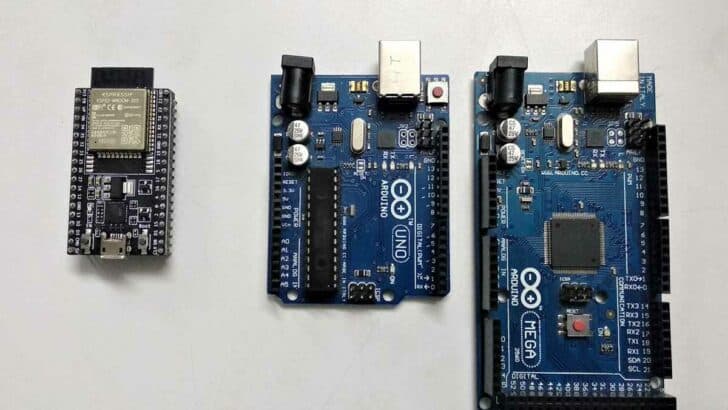Choosing the right Arduino compatible development board for your project can be a challenging task. With the wide variety of options available, it’s essential to understand the different features and capabilities of each board to make an informed decision.
In this blog post, we will compare the following 8 Arduino compatible development boards on the market:
- Arduino UNO
- ESP32 S2 DevKit C-1
- ESP32-C3-DevKitM-1
- Raspberry Pi Pico
- Arduino Nano 33
- TinyPico
- Arduino MKR WAN 1300
- Franzininho
We will focus on key aspects such as power consumption, speed, memory, IO capabilities, size, WIFI, Bluetooth, and logic levels.
Power consumption is a vital consideration for projects that require long battery life or operate in low-power environments. A board with low power consumption ensures efficient utilization of energy resources, allowing your project to run for extended periods without the need for frequent battery replacements or recharging.
Speed is another critical factor, especially for projects that involve real-time data processing or require quick response times. A board with high processing speed enables faster execution of code, ensuring smooth and seamless operation of your project.
Memory capacity is essential for projects that involve storing and manipulating large amounts of data. A board with ample memory allows you to store variables, arrays, and other data structures without running into memory limitations, thus enabling more complex and feature-rich applications.
IO capabilities refer to the number and types of input/output pins available on a development board. Having a sufficient number of IO pins allows you to connect various sensors, actuators, and other peripheral devices to your project, expanding its functionality and versatility.
Size is a crucial consideration, especially for projects with space constraints or those requiring portability. A compact and lightweight board allows for easier integration into smaller enclosures or wearable devices, making it ideal for projects where size matters.
WIFI and Bluetooth capabilities are essential for projects that require wireless communication. These features enable your project to connect to the internet, communicate with other devices, or even create a local network. Whether you need to send data to a remote server or control your project wirelessly, having WIFI and Bluetooth capabilities can greatly enhance the functionality and connectivity of your project.
Lastly, logic levels determine the voltage levels at which a board operates. It is important to ensure that the logic levels of your development board are compatible with the other components and devices you plan to use in your project. Mismatched logic levels can lead to compatibility issues and potential damage to the components.
Whether you are working on a low-power IoT application, a high-speed data processing project, or a compact wearable device, understanding these key features will enable you to choose the board that best suits your specific requirements. So, let’s dive in and explore the best Arduino compatible development boards for your project.
Makerguides.com is a participant in the Amazon Services LLC Associates Program, an affiliate advertising program designed to provide a means for sites to earn advertising fees by advertising and linking to products on Amazon.com. As an Amazon Associate we earn from qualifying purchases.
Arduino UNO
The Arduino UNO is a microcontroller board based on the ATmega328P. It has 14 digital input/output pins, 6 of which can be used as PWM outputs, 6 analog inputs, a 16 MHz quartz crystal, a USB connection, a power jack, an ICSP header, and a reset button.
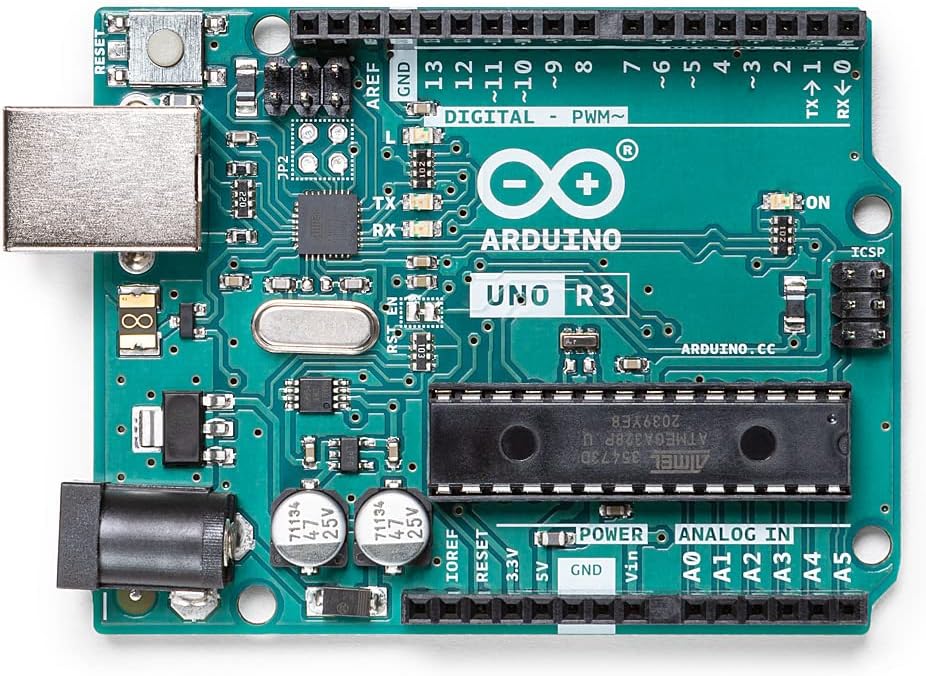
Compared to the other boards, the Arduino UNO has a lower power consumption. It operates at 5V, unlike the ESP32 S2 DevKit C-1, ESP32-C3-DevKitM-1, and Raspberry Pi Pico which operate at 3.3V. This makes the UNO less suitable for battery-powered projects.
In terms of speed, the UNO operates at 16 MHz, which is slower than the ESP32 boards and the Raspberry Pi Pico. However, it’s comparable to the Arduino Nano 33 and the Arduino MKR WAN 1300.
The Arduino UNO has 32 KB of flash memory, 2 KB of SRAM, and 1 KB of EEPROM. This is less memory than the ESP32 boards and the Raspberry Pi Pico, but similar to the Arduino Nano 33 and the Arduino MKR WAN 1300.
The UNO does not have built-in WiFi or Bluetooth capabilities, unlike the ESP32 boards, the Arduino Nano 33, and the Arduino MKR WAN 1300. However, these features can be added with additional shields.
In terms of size, the UNO is larger than the other boards, making it less suitable for compact projects.
The UNO operates at 5V logic levels, unlike the other boards which operate at 3.3V. This means that the UNO is not directly compatible with 3.3V devices without a logic level converter. While, most devices will work with 5V logic levels, it is something to watch out for.
The Arduino UNO is especially suited for beginners due to its simplicity and the large community support. It’s ideal for learning the basics of how microcontrollers and sensors work. It can be used in a wide range of applications, including robotics, home automation, and interactive art projects.
In conclusion, the Arduino UNO is a versatile board that’s great for beginners. However, its lack of built-in WiFi and Bluetooth, lower memory, and larger size may make it less suitable for more advanced projects.
Specification
See the detailed specification below:
| Parámetro | Descripción |
| Microcontrolador | ATMEGA328P |
| USB Connector | USB-B |
| Built-in LED pin | 13 |
| Number of Digital IOs | 14 |
| Number of Analog input pins | 6 |
| ADC resolution | 10 bits |
| Number of PWM pins | 6 |
| UART | 1 channel |
| I2C | 1 channel |
| SPI | 1 channel |
| I/O voltage | 5 V (6 V maximum) |
| Corriente continua por pin de E/S | 20 mA (do not exceed 100 mA per port) |
| Power-down current | 1 uA (at 25 ℃, MCU current) |
| Tensión de alimentación | 6 – 20 V (12 V typical) |
| 3.3 V output pin | 50 mA (maximum) |
| Velocidad del reloj | 16 MHz |
| SRAM | 2 KB |
| Flash | 32 KB (512 bytes for bootloader) |
| EEPROM | 1 KB |
| Timers | 2 x 8 bit, 1 x 16 bit |
| Peso | 25 g |
| Dimensiones | 53.4 mm x 68.6 mm |
| Reset button | Sí |
ESP32 S2 DevKit C-1
The ESP32 S2 DevKit C-1 is a powerful development board that stands out for its high-speed processing and advanced features. It operates on a 240 MHz clock speed, which is significantly faster than the Arduino UNO’s 16 MHz. This makes it ideal for applications requiring rapid data processing.
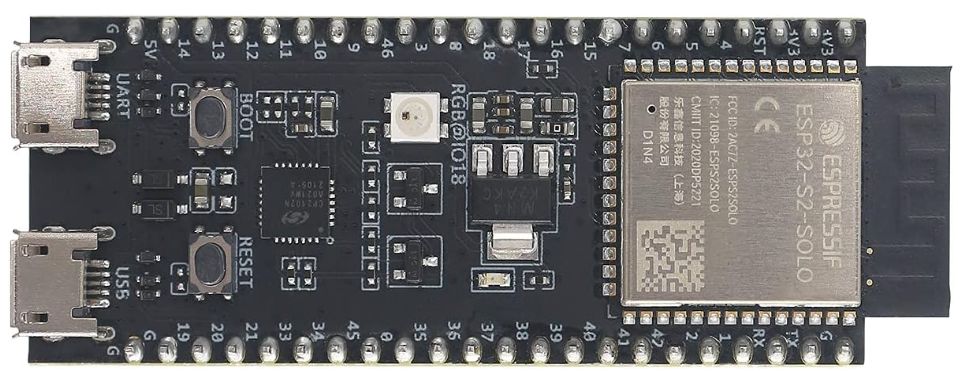
In terms of memory, the ESP32 S2 DevKit C-1 is also superior, boasting 320KB of SRAM and 128KB of ROM. This is much larger than the Arduino UNO’s 2KB SRAM and 32KB flash memory, and even surpasses the Raspberry Pi Pico’s 264KB SRAM.
The ESP32 S2 DevKit C-1 also excels in IO capabilities. It has 42 programmable GPIOs, far more than the Arduino UNO’s 14 and the Arduino Nano 33’s 20. This makes it suitable for complex projects requiring multiple inputs and outputs.
Size-wise, the ESP32 S2 DevKit C-1 is compact, making it a good choice for projects with space constraints. However, it’s slightly larger than the TinyPico and Franzininho Board.
One of the key features of the ESP32 S2 DevKit C-1 is its built-in WiFi module. This sets it apart from boards like the Arduino UNO and Arduino Nano 33, which lack this feature. However, it doesn’t have Bluetooth capabilities, unlike the ESP32-C3-DevKitM-1 and Arduino Nano 33.
The ESP32 S2 DevKit C-1 operates at 3.3V logic level, similar to the Raspberry Pi Pico, Arduino Nano 33, and TinyPico. This is lower than the Arduino UNO’s 5V, but higher than the Franzininho Board’s 3V.
Given its advanced features, the ESP32 S2 DevKit C-1 is best suited for intermediate to advanced users. It’s especially useful for IoT projects, thanks to its WiFi capabilities and high number of GPIOs.
In summary, the ESP32 S2 DevKit C-1 is a high-speed, memory-rich board with excellent IO capabilities and WiFi functionality. Its compact size and 3.3V logic level make it versatile, although its lack of Bluetooth and higher complexity may not make it the best choice for beginners or for projects requiring Bluetooth connectivity.
Specification
See the detailed list of features below:
| Parámetro | Descripción |
| Processor | 32-bit Xtensa single core @ 240 MHz |
| Wi-Fi | Yes, IEEE802.11 b/g/n, 2.4 GHz |
| SRAM | 320 KB (16 KB for RTC) |
| PSRAM (based on variant) | 2 MB |
| ROM | 128 KB |
| SPI flash | 4 MB |
| GPIOs | 43 |
| SPI | 4 channels |
| UART | 2 channels |
| Toque | Sí |
| ADC resolution | 12 bits |
| DAC | 2 x 8-bit |
| LED-PWM Controller | Upto 8-channels |
| Pulse counters | 4 |
| USB | USB-OTG full-speed |
| LEDs | 3.3 V power LED, RGB user LED (GPIO 18) |
| Button | Reset button, BOOT button |
| Antenna | Onboard PCB antenna |
| USB-UART bridge | Yes, USB 1.1 compliant |
| Potencia | 3.3 V to 5 V, 500 mA (minimum) |
| High-level source current | 40 mA (maximum) |
| Low-level sink current | 28 mA (maximum) |
| TX Peak current (Active RF) | 310 mA |
| RX peak current | 75 mA |
| Deep sleep with RTC | 25 uA |
| Power-off mode | 1 uA |
| Bergstick connector | 2.54 mm pitch |
| Dimensiones | 62.74 mm x 25.4 mm |
| Connectors | 1 x Micro USB for COM port, 1 x Micro USB for USB-OTG |
ESP32-C3-DevKitM-1
The ESP32-C3-DevKitM-1 is a powerful development board from Espressif. It is based on the ESP32-C3 Wi-Fi & Bluetooth LE 5.0 microcontroller. This board stands out for its low power consumption and high performance.
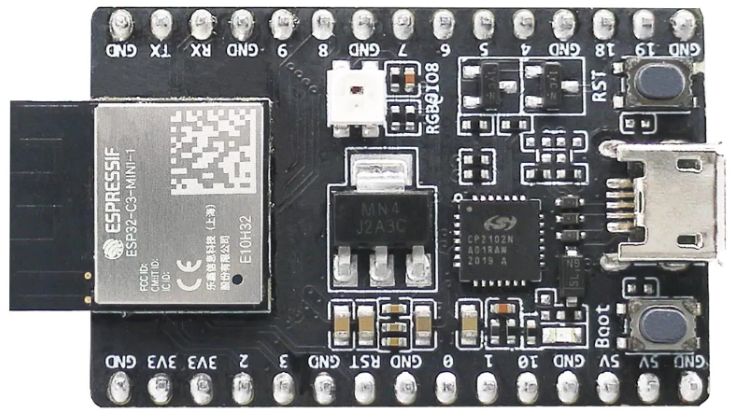
Compared to the Arduino UNO, the ESP32-C3-DevKitM-1 is more power-efficient. It operates at a lower voltage level, which significantly reduces its power consumption. This makes it an ideal choice for projects that require long-term operation on a single power source.
In terms of speed, the ESP32-C3-DevKitM-1 outperforms the ESP32 S2 DevKit C-1. It features a 160 MHz clock speed, compared to the 80 MHz of the ESP32 S2 DevKit C-1. This makes it twice as fast, allowing it to handle more complex tasks with ease.
The ESP32-C3-DevKitM-1 also boasts more memory than the Raspberry Pi Pico. It features 400 KB SRAM, while the Pico only has 264 KB. This extra memory allows the ESP32-C3-DevKitM-1 to store more data and run more complex programs.
When it comes to IO capabilities, the ESP32-C3-DevKitM-1 is similar to the Arduino Nano 33. Both boards have a large number of GPIO pins, allowing them to interface with various sensors and devices.
The ESP32-C3-DevKitM-1 is larger than the TinyPico, but smaller than the Arduino MKR WAN 1300. This makes it a good middle-ground option for projects that require a balance between size and functionality.
Unlike the Franzininho Board, the ESP32-C3-DevKitM-1 features built-in Wi-Fi and Bluetooth capabilities. This allows it to connect to the internet and other devices wirelessly, expanding its range of potential applications.
The logic levels of the ESP32-C3-DevKitM-1 are 3.3V, which is common among modern development boards. This makes it compatible with a wide range of sensors and devices.
The ESP32-C3-DevKitM-1 is suitable for intermediate to advanced users due to its high performance and complex features. However, beginners can also use it with some guidance.
This board is especially suited for IoT projects due to its Wi-Fi and Bluetooth capabilities. It can also handle projects that require high processing power and memory, such as data logging and complex sensor interfacing.
In conclusion, the ESP32-C3-DevKitM-1 is a versatile and powerful development board. It offers a good balance between size, power consumption, and functionality, making it a great choice for a wide range of projects.
Specification
For the full specification, see the table below:
| Parámetro | Descripción |
| Processor | 32-bit RISC-V single-core @160 MHz |
| Wi-Fi | Yes, IEEE802.11 b/g/n, 2.4 GHz |
| Bluetooth | LE 5 |
| SRAM | 400 KB (16 KB for cache) |
| RTC SRAM | 8 KB SRAM for RTC |
| ROM | 384 KB |
| eFuse | 4 Kbit |
| I2C, I2S | 1 channel each |
| GPIOs | 22 |
| SPI | 3 channels |
| UART | 2 x channel |
| ADC | 2 x 12-bit SAR ADCs |
| ADC resolution | 12 bits |
| Timers | 2 x 54-bit general-purpose timers3 x digital watch timer1 x analog watchdog timer1 x 52-bit system timer |
| Power modes | ActiveModem-sleepLight-sleepDeep-sleep |
| Buttons | Reset and Boot |
| RF-modules | +21 dBm for an 802.11b transmission+20 dBm for an 802.11n transmission-105 dBm sensitivity for LE receiver (125 Kbps) |
| LEDs | RGB user LED5V power LED |
| USB | 1 x micro USB port |
| Low-Power consumption | Light sleep – 130 uA Deep-sleep – 5 uA Power-off – 1 uA |
| Active (RF-working) | Transmit – 335 mA peakReceive – 87 mA peak |
| Bluetooth LE frequency range | 2402 – 2480 MHz |
| Power input (mutually exclusive) | 5 V via USB cable OR5 V and GND via headers OR3.3 V and GND via headers |
| GPIO voltage HIGH input | 2.475 V minimum |
| GPIO voltage Low input | 0.66 V minimum |
| IOH Output high source current | 40 mA |
| IOL Output low sink current | 28 mA |
| Peso | 18 g |
| Header pitch | 2.54 mm |
| Dimensiones | 38.91 mm x 25.4 mm |
Raspberry Pi Pico
The Raspberry Pi Pico is a compact and cost-effective development board. It’s powered by the RP2040 microcontroller chip, which contains a dual-core Arm Cortex-M0+ processor. With a clock speed of 133MHz, it offers a balance between power and energy efficiency.
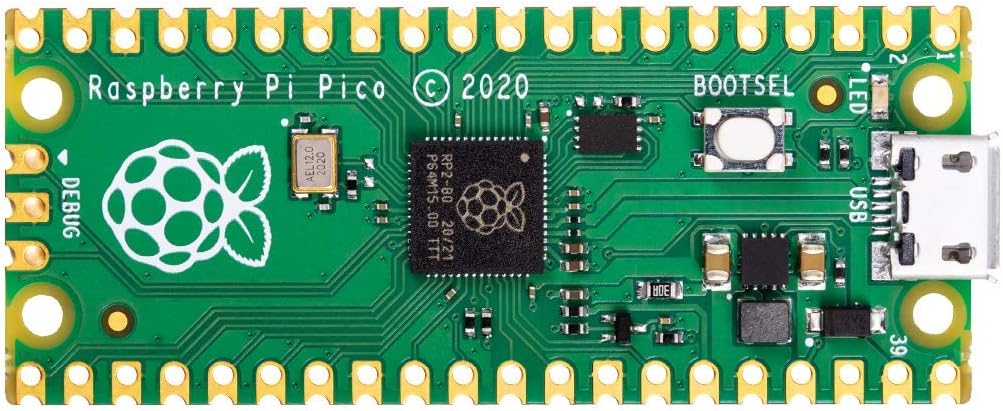
Compared to the Arduino UNO, the Pico has a higher processing speed and more memory. It comes with 264KB of SRAM and 2MB of onboard Flash memory. However, unlike the UNO, it doesn’t have built-in WiFi or Bluetooth capabilities.
In terms of IO capabilities, the Pico is quite versatile. It has 26 GPIO pins, including 3 analog inputs. This is more than the ESP32 S2 DevKit C-1 and ESP32-C3-DevKitM-1, which have 18 and 22 GPIO pins respectively.
The Pico operates at 3.3V logic levels, which is the same as the Arduino Nano 33, TinyPico, and Arduino MKR WAN 1300. However, it’s different from the Franzininho Board, which operates at 5V.
Size-wise, the Pico is one of the smallest boards on this list. It’s even smaller than the TinyPico, making it ideal for projects where space is a premium.
Despite its advanced features, the Raspberry Pi Pico is suitable for beginners. It’s designed to be easy to program, with support for MicroPython, C, and C++.
The Pico is especially suited for applications that require low power consumption and high performance. These include wearable tech, robotics, and IoT devices. However, if you need WiFi or Bluetooth connectivity, you might want to consider the ESP32 boards or the Arduino MKR WAN 1300 instead.
Specification
In the following the full specification of the board:
| Parámetro | Descripción |
| Microcontrolador | RP2040 |
| Core | Arm Cortex-M0+ |
| Reloj | Upto 133 MHz |
| SRAM | 264 KB |
| QSPI Flash | 2 MB |
| GPIO | 26 |
| Analog Inputs | 3 |
| PIO (programmable I/O) | 8 |
| UART | 2 |
| SPI controller | 2 |
| I2C | 2 |
| PWM channels | 16 |
| USB | USB 1.1 with host and device support |
| Debug port | Yes, 3 Pin SWD (Serial Wire Debug) |
| ADC | Yes, 12-bit |
| GPIO input HIGH voltage | 2 V (minimum) |
| GPIO input LOW voltage | 0.8 V (maximum) |
| Supported input voltage | 1,8 V a 5,5 V |
| Consumo actual | 93 mA (Active)1.9 ma (sleep) |
| I/O Voltage levels | 3.3 V |
| Dimensiones | 21 mm x 51 mm |
| Peso | 17.97 g |
Arduino Nano 33
The Arduino Nano 33 is a compact and powerful development board. It is a significant upgrade from the Arduino UNO in terms of speed, memory, and power consumption.
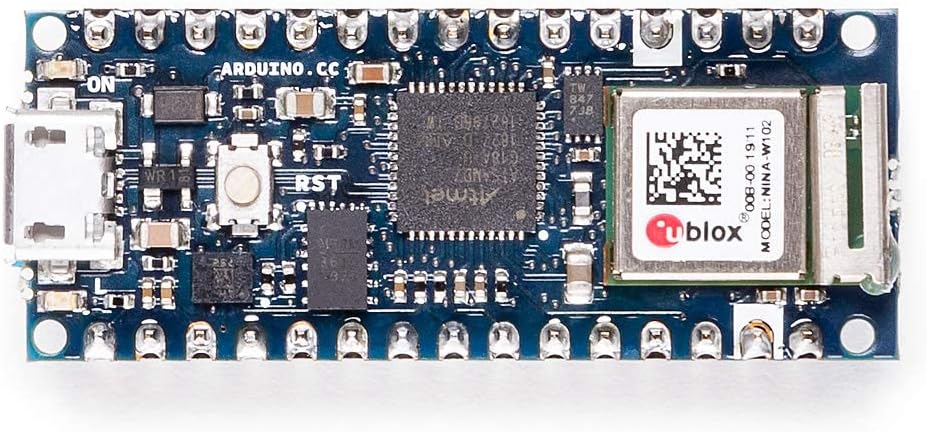
Unlike the Arduino UNO, which operates at 16 MHz, the Arduino Nano 33 runs at a speed of 64 MHz and uses a SAMD21 Cortex M0. This makes it four times faster, allowing for quicker data processing and response times.
In terms of memory, the Nano 33 also outperforms the UNO. It has 256 KB of flash memory and 32 KB of SRAM, compared to the UNO’s 32 KB of flash memory and 2 KB of SRAM. This increased memory allows for more complex programs and data storage.
The Nano 33 is also more power-efficient. It operates at a lower voltage (3.3V) compared to the UNO’s 5V. This lower operating voltage results in less power consumption, making the Nano 33 ideal for battery-powered projects.
When it comes to IO capabilities, the Nano 33 is comparable to the UNO, with 14 digital IO pins and 8 analog input pins. However, the Nano 33 also includes built-in WiFi and Bluetooth capabilities, which the UNO lacks.
In terms of size, the Nano 33 is much smaller than the UNO, making it suitable for projects where space is a constraint.
Compared to the ESP32 S2 DevKit C-1 and ESP32-C3-DevKitM-1, the Nano 33 lacks some features such as a touch sensor and temperature sensor. However, it makes up for this with its lower power consumption and smaller size.
The Raspberry Pi Pico is a more powerful board with a faster processor and more memory. However, it lacks the built-in WiFi and Bluetooth capabilities of the Nano 33.
The TinyPico and Arduino MKR WAN 1300 are similar to the Nano 33 in terms of features, but they operate at a higher voltage and have higher power consumption.
The Franzininho Board is a simpler board with fewer features, making the Nano 33 a more versatile choice.
The Arduino Nano 33 is suitable for intermediate to advanced users due to its advanced features and capabilities. It is especially suited for IoT projects due to its built-in WiFi and Bluetooth capabilities.
Specification
Here the full specification of the board:
| Parámetro | Descripción |
| Microcontrolador | SAMD21 Cortex M0+ 32 bit MCU |
| Módulo de radio | U-blox NINA-W102 |
| Velocidad del reloj | 48 MHz |
| Memoria flash de la CPU | 256 KB |
| SRAM | 32 KB |
| Digital I/O | 14 |
| Pines PWM | 11 |
| UART | 1 |
| SPI | 1 |
| I2C | 1 |
| Analog Input pins | 8 |
| ADC resolution | 12 bit |
| Analog Output pins | 1 (DAC) |
| USB | Both device and host mode |
| Built-in Power On Reset (POR) | Yes, ~1.45 V |
| Timers | 16-bit x 524-bit x 3 |
| WiFi | IEEE 802.11b up to 11Mbit IEEE 802.11g up to 54MBit IEEE 802.11n up to 72MBit |
| Bluetooth | 2.4 GHz, 79 channels Upto 3 Mbit/s |
| Logic HIGH input voltage | 1.815 V (minimum) |
| Logic LOW input voltage | 0.99V (maximum) |
| Tensión de funcionamiento | 3.3 V |
| Input voltage | 5 V to 21 V (maximum) Best efficient at 12 V |
| DC current per pin | 7 mA |
| CPU Active current | 7 mA (maximum) |
| CPU standby current | 12.8 uA (with RTC) |
| LEDs | User LED Power LED |
| Dimension | 43.16 mm x 17.77 mm |
| Peso | 5 g |
TinyPico
The TinyPico is a compact, yet powerful development board. It is significantly smaller than the Arduino UNO and the ESP32 DevKits, making it a great choice for projects where space is a constraint. Despite its small size, it packs a punch with a 32-bit dual-core processor that runs at 240 MHz, which is faster than the Arduino UNO’s 16 MHz.
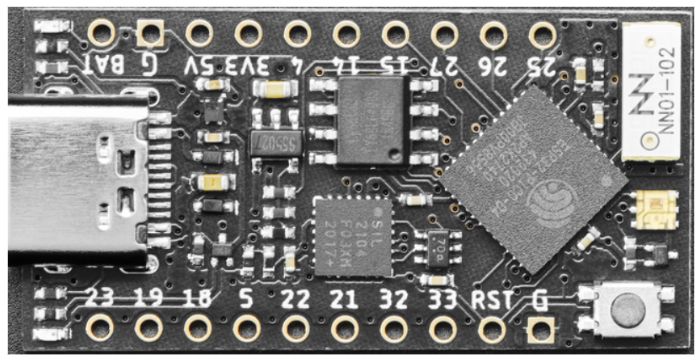
In terms of memory, the TinyPico stands out with 4MB of flash memory and 520KB of SRAM. This is more than the Arduino UNO’s 32KB flash memory and 2KB SRAM, and comparable to the ESP32 DevKits.
The TinyPico also excels in power consumption. It uses just 20µA in deep sleep mode, which is less than the ESP32 DevKits and much less than the Arduino UNO. This makes the TinyPico an excellent choice for battery-powered projects.
When it comes to IO capabilities, the TinyPico offers 18 GPIO pins. This is fewer than the Arduino UNO’s 20 and the ESP32 DevKits’ 34, but still sufficient for many applications.
Unlike the Arduino UNO and the Raspberry Pi Pico, the TinyPico comes with built-in WiFi and Bluetooth capabilities. This makes it a great choice for IoT projects.
The TinyPico operates at 3.3V logic levels, which is the same as the ESP32 DevKits and the Arduino Nano 33, but different from the Arduino UNO’s 5V.
Given its advanced features, the TinyPico is best suited for intermediate to advanced users. Beginners might find it a bit challenging, but with some effort, they can certainly get the hang of it.
In terms of applications, the TinyPico is especially suited for IoT projects, wearable tech, and any project where size and power consumption are critical factors.
In conclusion, the TinyPico is a small, powerful, and energy-efficient development board with built-in WiFi and Bluetooth capabilities. It is a great choice for intermediate to advanced users working on IoT projects or any application where size and power consumption are key considerations.
Specification
Below the specification for the TinyPico:
| Parámetro | Descripción |
| Core | 32-bit Dual core |
| Reloj | 240 MHz |
| PSRAM | 4 MB |
| USB | Type C, USB+Serial for programming |
| LIPO battery management | Sí |
| Antenna | Onboard |
| Button | RESET button |
| USB to UART driver | WCH9102F/similar |
| ADC | 12 bit |
| GPIO | 14 |
| On-chip Sensor | Hall Sensor |
| SPI flash (integrated) | 4 MB |
| Logic HIGH current | 40 mA |
| Logic LOW current | 28 mA |
| GPIO logic LOW input | 0.825 V (maximum) |
| GPIO logic HIGH input | 2.475 V (minimum) |
| Supply current | 80 mA |
| Operating voltage of MCU | 3 V – 3.6 V |
| Battery charging current | 330 mA |
| LEDs | Power LED Charging Indication LED User RGB LED |
| WiFi-Radio | 2.412 – 2.484 GHz |
| BLE Sensitivity | -97 dBm typical |
| BLE RF transmit power | 0 dBm (Typical) |
| RF power control range | -12 to 9 dBm |
| Dimension | 18 mm x 35 mm |
| Peso | 11 g |
Arduino MKR WAN 1300
The Arduino MKR WAN 1300 is a powerful development board that stands out for its low power consumption and high-speed performance. Unlike the Arduino UNO, which operates at 5V, the MKR WAN 1300 operates at 3.3V, making it more energy-efficient.
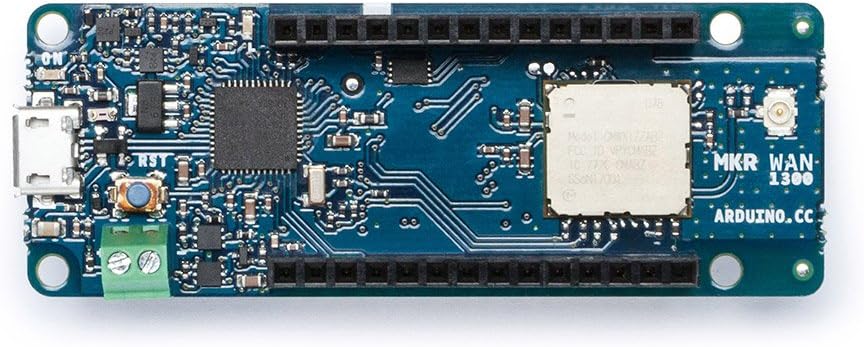
This board is equipped with a 32-bit ARM Cortex-M0+ microcontroller, which gives it a speed advantage over the 8-bit microcontroller of the Arduino UNO. It also surpasses the ESP32 S2 DevKit C-1 and ESP32-C3-DevKitM-1 in terms of memory, boasting 256 KB of flash memory and 32 KB of SRAM.
In terms of IO capabilities, the MKR WAN 1300 offers 22 digital I/O pins, which is more than the Raspberry Pi Pico’s 20. However, it falls short of the ESP32 boards, which offer 34 and 22 respectively.
The Arduino MKR WAN 1300 is compact in size, making it smaller than the Arduino UNO and Raspberry Pi Pico. However, it’s slightly larger than the Arduino Nano 33 and TinyPico.
One of the key features of the MKR WAN 1300 is its LoRa connectivity, which sets it apart from the other boards. While it lacks built-in WiFi and Bluetooth capabilities, it excels in long-range, low-power communication, making it ideal for IoT applications.
The logic levels of the MKR WAN 1300 are 3.3V, unlike the Arduino UNO which operates at 5V. This makes it compatible with a wider range of sensors and peripherals.
The MKR WAN 1300 is suitable for intermediate to advanced users due to its complex features and capabilities. It’s especially suited for applications that require long-range communication, such as remote sensor networks, home automation, and IoT projects.
In comparison, the Franzininho Board is a simpler, DIY board that’s more suited for beginners. It operates at 5V and has fewer I/O pins, making it less versatile but easier to handle for those just starting out in electronics.
In conclusion, the Arduino MKR WAN 1300 is a robust and versatile board that offers a unique set of features, making it a great choice for more advanced projects requiring long-range communication and low power consumption.
Specification
The following table shows the complete specification of the board:
| Parámetro | Descripción |
| MCU | SAMD21G18A, SAMD21 Cortex M0+, 32 bit core |
| Flash | 256 KB |
| SRAM | 32 KB |
| Clock Frequency | 48 MHz |
| ADC | 7 analog pins |
| ADC Resolution | 12 bits |
| DAC | 1 |
| Pines de E/S digitales | 8 |
| Pines PWM | 13 |
| Interrupciones externas | 10 |
| UART | 1 |
| I2C | 1 |
| SPI | 1 |
| LoRa | Murata CMWX1ZZABZ |
| LoRa Carrier Frequency | 433 / 868 / 915 MHz |
| Digital I/O votlage | 3.3 V |
| Corriente continua por pin de E/S | 7 mA |
| Nominal input voltage | 5 – 5.5 V |
| CPU Active current | 7 mA (maximum) |
| CPU standby current | 12.8 uA (with RTC) |
| LEDs | Power-on LEDUser LED |
| Dimension | 25 mm x 67.6 mm |
| Peso | 32 g |
Franzininho Board
The Franzininho Board is an Arduino-compatible development board designed for educational purposes. It is based on the ATtiny85 microcontroller, which is a low-power, 8-bit AVR RISC-based microcontroller.
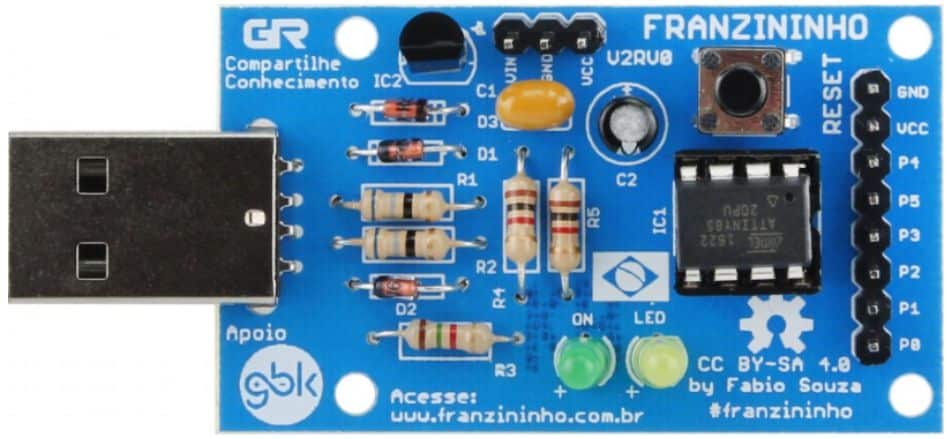
Compared to the other boards, Franzininho Board’s power consumption is relatively low due to its small size and simplicity. It operates at a speed of 20 MHz, which is slower than the ESP32 S2 DevKit C-1 and ESP32-C3-DevKitM-1, but comparable to the Arduino UNO and Arduino Nano 33.
In terms of memory, the Franzininho Board has 8 KB of flash memory and 512 bytes of SRAM. This is significantly less than the ESP32 boards and Raspberry Pi Pico, but similar to the Arduino UNO and Nano 33.
The Franzininho Board has 6 I/O pins, fewer than most of the other boards. It lacks the WiFi and Bluetooth capabilities found in the ESP32 boards and Arduino MKR WAN 1300. Its logic levels are 5V, unlike the 3.3V logic levels of the ESP32 boards, Raspberry Pi Pico, and Arduino Nano 33.
The Franzininho Board is one of the smallest boards in the list, making it suitable for compact projects. However, its simplicity and lack of advanced features make it less suitable for complex, high-performance applications.
The Franzininho Board is ideal for beginners due to its simplicity and ease of use. It is especially suited for educational purposes and simple DIY projects. It can be used to learn about microcontrollers, programming, and electronics in a hands-on way.
In conclusion, the Franzininho Board is a simple, low-power, and compact Arduino-compatible development board. It is ideal for beginners and educational purposes, but may not be suitable for advanced users or complex projects.
Specification
Here the specification of the Franzininho Board:
| Parámetro | Descripción |
| Core | Low power 8-bit MCU |
| EEPROM | 512 bytes |
| Flash | 8 KB |
| SRAM | 512 bytes |
| ADC | yes |
| ADC resolution | 10 bits |
| LEDs | Power LED USer LED |
| I2C | 1 |
| SPI | 1 |
| Pines de entrada analógica | 4 |
| Digital I/O | 6 |
| USB | Sí |
| Power supply input | USB, 5 V |
| GPIO input HIGH voltage | 3 V |
| GPIO input LOW voltage | 1.5 V |
| Active current consumption | 8 mA |
| Power down mode | 10 uA (maximum) |
Conclusions
After comparing the various Arduino compatible development boards, it is clear that each board has its own unique features and advantages.
The Arduino UNO is a popular choice for beginners due to its simplicity and ease of use. It offers a wide range of shields and libraries, making it versatile for different projects.
The ESP32 S2 DevKit C-1 stands out for its powerful processing capabilities and built-in Wi-Fi and Bluetooth connectivity. It is ideal for IoT applications and projects that require wireless communication.
The ESP32-C3-DevKitM-1 is another impressive board from the ESP32 series, featuring a powerful processor and support for both Wi-Fi and Bluetooth. It also offers a compact form factor, making it suitable for projects with limited space.
The Raspberry Pi Pico is a microcontroller board that offers a lot of power in a small package. It is based on the RP2040 chip and supports MicroPython, making it a great choice for Python enthusiasts.
The Arduino Nano 33 is a compact board that offers a wide range of features, including Bluetooth connectivity and a built-in IMU. It is suitable for projects that require motion sensing or wireless communication.
The TinyPico is a tiny board that packs a punch. It offers built-in Wi-Fi and Bluetooth, making it perfect for IoT projects. Despite its small size, it offers a lot of power and features.
The Arduino MKR WAN 1300 is designed for projects that require long-range communication. It supports LoRaWAN connectivity, making it ideal for applications such as remote monitoring and tracking.
The Franzininho Board is a Brazilian-made board that offers a compact form factor and compatibility with the Arduino IDE. It is a great choice for beginners and hobbyists but hard to come by.
In conclusion, choosing the best Arduino compatible development board depends on the specific requirements of your project. Whether you need simplicity, wireless connectivity, compactness, or long-range communication, there is a board that will suit your needs. Consider the features and advantages of each board to make an informed decision for your next project.
Finally, note that we also have some in-detail comparisons of some of these and other boards:
- NodeMCU ESP8266 Vs. Arduino UNO Board
- Comparación de la velocidad de ESP32 vs Arduino
- Arduino Nano Board Guide
- Arduino Vs. Raspberry Pi – What is the difference?
Stefan is a professional software developer and researcher. He has worked in robotics, bioinformatics, image/audio processing and education at Siemens, IBM and Google. He specializes in AI and machine learning and has a keen interest in DIY projects involving Arduino and 3D printing.

